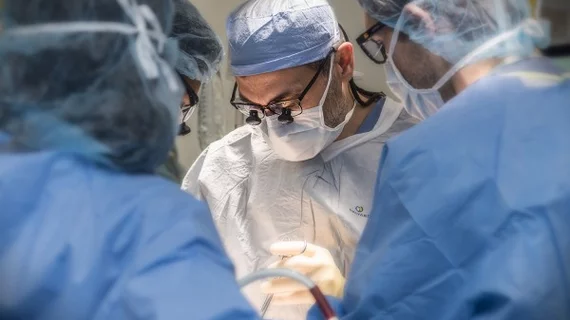Repeat surgery vs. PCI in patients with a history of CABG: A complex decision for heart teams to consider
When treating patients with prior coronary artery bypass grafting (CABG) surgery and recurrent angina, repeat CABG is associated with a better mortality rate than percutaneous coronary intervention (PCI). PCI, however, is associated with better operative outcomes, meaning clinicians will need to weight the risks and benefits of each treatment option when deciding how to proceed.
These takeaways come from a new meta-analysis published in JTCVS Open, an open-access journal from the American Association for Thoracic Surgery.[1]
“These patients are known to be older and more comorbid than at the time of the primary surgery and therefore both PCI and CABG can expose them to a higher peri-procedural risk and higher operative mortality,” wrote first author Arnaldo Dimagli, MD, of the department of cardiothoracic surgery at Weill Cornell Medicine in New York City, and colleagues. “Moreover, patients eligible for CABG may not have available conduits for the grafting. Current North American and European guidelines support PCI over CABG in most patients. However, CABG is recommended in patients with extensively diseased grafts or native coronary vessels, especially when there is no patent arterial graft supplying the myocardium.”
Dimagli’s team reviewed data from seven different studies, focusing on nearly 10,000 patients. The studies were originally completed from 1996 to 2019. Two separate reviewers extracted patient data, with a third reviewer resolving any conflicts the group identified. The primary outcome for this meta-analysis was all-cause mortality. Repeat revascularization, peri-operative stroke and myocardial infarction (MI) were among the secondary outcomes.
Overall, 57% of patients who presented with a prior CABG and recurrent angina underwent PCI or angioplasty. The other 43% underwent repeat CABG.
There was actually no significant difference in the incidence rate of follow-up mortality between these two treatment methods. However, during a mean follow-up period of 5.7 years, PCI was associated with a clear “survival benefit”: reducing a patient’s mean survival time by nearly one year. Also, PCI was associated with a consistently higher rate of repeat revascularizations than repeat CABG.
On the other hand, PCI was linked to a reduced risk of operative mortality and post-operative stroke; there was no difference between the two treatment options in the risk of post-operative MI.
“Patients requiring repeat revascularization after primary CABG represent a high-risk surgical cohort because they are usually older and present with a more adverse burden of comorbidities,” the authors wrote. “Moreover, repeat CABG carries procedural hazards related to re-sternotomy which can be particularly risky for the presence of retrosternal bypass conduits, whose injury may result in peri-procedural MI in a significant proportion of patients. There is also an increased risk of injuries to the heart and great vessels during mediastinal and heart dissection, complicated by fibrotic adherences from the previous CABG. This extra care needed during re-sternotomy and chest dissection prolongs the operative times of repeat CABG. All these factors account for the higher operative mortality following repeat CABG compared to primary CABG.”
Dimagli et al. concluded that, when these situations arise, heart teams should consider every angle and work with the patient to identify the most suitable treatment option.

